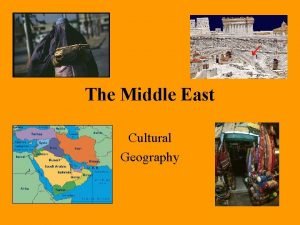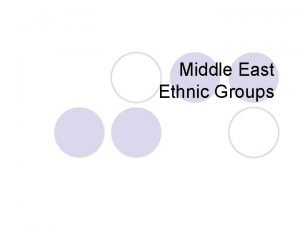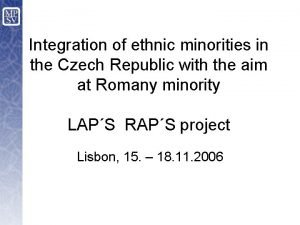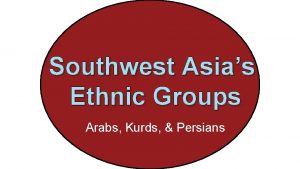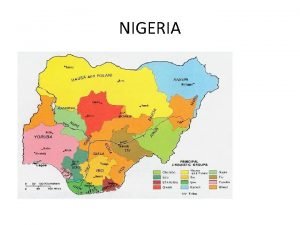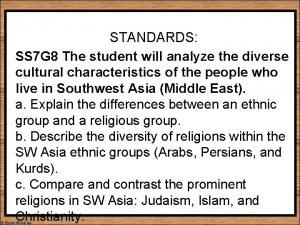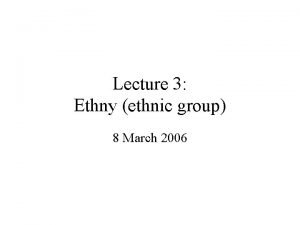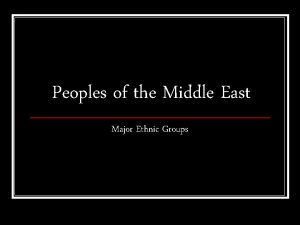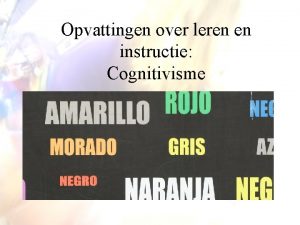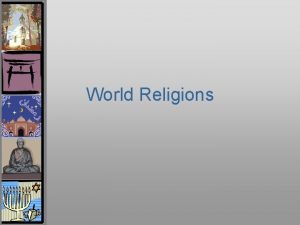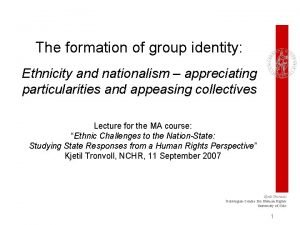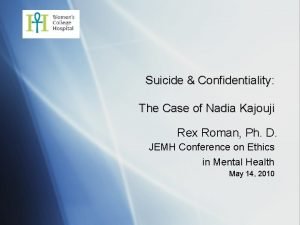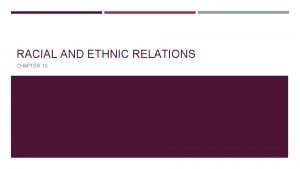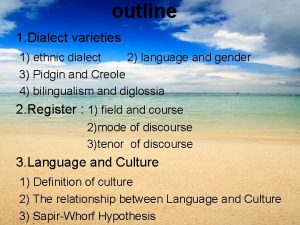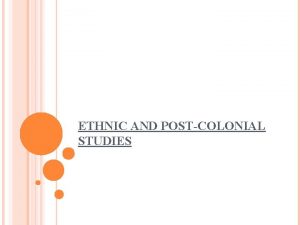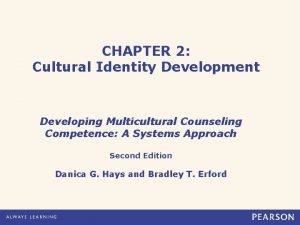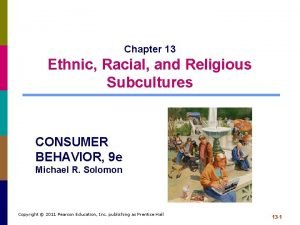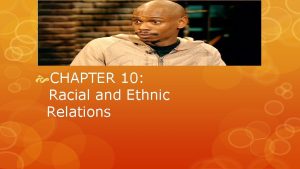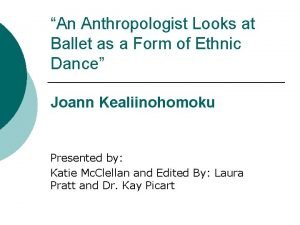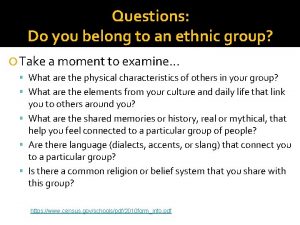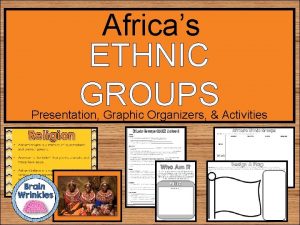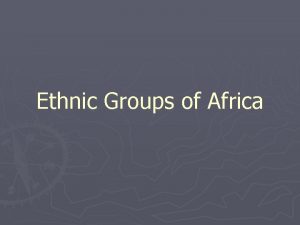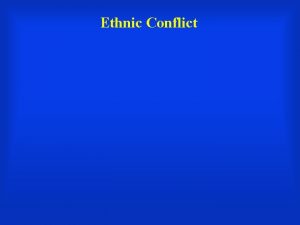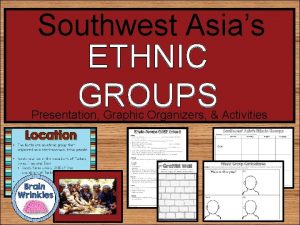Africas ETHNIC GROUPS Presentation Graphic Organizers Activities STANDARDS































































- Slides: 63

Africa’s ETHNIC GROUPS Presentation, Graphic Organizers, & Activities

STANDARDS: SS 7 G 4 Analyze the diverse cultural characteristics of the people who live in Africa. a. Explain the differences between an ethnic group and a religious group. b. Describe the diversity of religions within African ethnic groups. © Brain Wrinkles

African Ethnic Groups Arab, Ashanti, Bantu, & Swahili © Brain Wrinkles

Religious Group • This is a group of people who share a common belief system. • A religious group is identified based on mutual religious beliefs and practices. • They believe in the same god (or gods) and have a common sacred text with a specific set of rules about how to live. © Brain Wrinkles

Religious Group • Religious groups have many things in common: • God(s), prophets, prayers, history, sacred text, religious laws, holy days, etc. • People from different ethnic groups may share the same religion; however, they may be from different cultures. © Brain Wrinkles

© Brain Wrinkles

Traditional African Religions • Many Africans practice traditional religions that have been passed down for generations. • Traditional religions are part of everyday life in Africa. • These beliefs influence foods Africans eat, clothes they wear, how they marry, treat illness, bury their dead, etc. © Brain Wrinkles

Islam & Christianity • • • Most Africans today are either Muslim or Christian. Arabs from Southwest Asia brought Islam to Northern Africa around 700 CE. • They converted many Africans and Islam slowly spread throughout Northern Africa over time. Christianity first came to Africa in the middle of the first century. • Since then, missionaries have continued to spread their beliefs across sub. Saharan Africa. © Brain Wrinkles

Ethnic Group • This is a group of people who share common cultural characteristics. • They are identified on the basis of religion, race, or national origin. • Ethnic groups can have many things in common: • Shared history, common ancestry, language, religion, traditions, beliefs, holidays, food, etc. © Brain Wrinkles

Ethnic Group • These characteristics have been part of their community for generations. • All of these things make up a common culture that is shared by the members of the ethnic group. • There are more than 3, 000 ethnic groups in Africa, but some of the main ones are the Arabs, Ashanti, Bantu, and Swahili. © Brain Wrinkles

Ethnic Groups in Africa © Brain Wrinkles

ARABS © Brain Wrinkles

Location • Most of Africa’s Arab population is found in the countries of Northern Africa. • While the majority of Arabs are in North Africa, the gold and salt trade spread the Arab culture beyond the Sahara into the Sahel region and beyond. © Brain Wrinkles

© Brain Wrinkles

© Brain Wrinkles

Ancestry • Arab people began to spread into North Africa in the late 600 s, when the first Muslim armies arrived in Egypt. • Arab armies, traders, and scholars soon spread across northern Africa all the way to Morocco. • Wherever the Arabs went, they took Islam and the Arabic language with them. © Brain Wrinkles

© Brain Wrinkles

Ancestry • Arabic was necessary to be able to read the Quran, Islam’s holy book. • The Arabic language, the religion of Islam, and many other aspects of Muslim culture became part of Africa. © Brain Wrinkles

© Brain Wrinkles

Religion • Most Arabs practice Islam, while small numbers of Arabs practice other religions. • Not all Arabs are Muslims, and not all Muslims are Arabs. • Islam consists mostly of two different groups. • The majority of Muslims practice Sunni Islam, and most others practice Shi’a Islam. • Sunnis and Shi’a disagree about who is in charge of the Muslim world. © Brain Wrinkles

The mosque in Djenne, Mali is the oldest mud brick building in the world. © Brain Wrinkles

Religion • Sunni Islam dominates in most Arab areas, especially in North Africa. • Shi’a Islam is dominant among the Arab population in most of Southwest Asia. © Brain Wrinkles

© Brain Wrinkles

© Brain Wrinkles

Language • The term “Arab” refers to an ethnic group made up of people who speak the Arabic language. • Most Arabs, whether they are Muslim or Christian, speak Arabic. © Brain Wrinkles

© Brain Wrinkles

Arab Girls’ School in Egypt © Brain Wrinkles

Let’s Review • The majority of Arab people are found in Southwest Asia and northern Africa. • The language of the Arab people is Arabic. • Most Arabs, but not all, practice Islam. © Brain Wrinkles

ASHANTI © Brain Wrinkles

Location • Prior to European colonization, the Ashanti people developed a large and influential empire in West Africa. • Today, they live predominately in Ghana and Ivory Coast. • The total Ashanti population is over 7 million. © Brain Wrinkles

© Brain Wrinkles

Ancestry • In 1701, a meeting of all the clan chiefs in the region was held. • In this meeting, it was said that a Golden Stool was produced from the heavens by a priest and landed on the lap of Osei Tutu, the first king. • The Golden Stool was declared to be the symbol of the new Ashanti kingdom. © Brain Wrinkles

© Brain Wrinkles Golden Stool of the Ashanti (Replica)

Ancestry • The Golden Stool is sacred to the Ashanti, as it is believed that the kingdom will last as long as it remains in the hands of the Ashanti king. • The Golden Stool is an Ashanti legend and has only been seen by the tribe's royalty. • Only the king and trusted advisers know the hiding place of the stool. © Brain Wrinkles

Bells are attached to the side to warn the king of impending danger. © Brain Wrinkles

Religion • Ashanti religion is a mixture of supernatural and animist powers. • Animism is the belief that plants, animals, and trees have souls. • Ashanti believe in a supreme god who takes on various names depending upon the region of worship. • They believe lower gods, like spirits, are on earth to assist humans. © Brain Wrinkles

© Brain Wrinkles

Language • The major dialect of the Ashanti language is called ‘Asante’, or ‘Twi’. • It is spoken in and around Kumasi, the capital of the former Ashanti empire, and within the current subnational Asante Kingdom in Ghana. © Brain Wrinkles

© Brain Wrinkles

Let’s Review • They live predominately in Ghana and Ivory Coast. • Most speak Twi (or Asante). • The Ashanti religion is a mixture of spiritual and supernatural powers. • They believe that plants, animals, and trees have souls (animism). • The Golden Stool legend is very important to Ashanti culture. © Brain Wrinkles

BANTU © Brain Wrinkles

Location • Bantu generally refers to nearly 600 ethnic groups in Africa who speak Bantu languages. • The Bantu people are distributed throughout central and southern parts of the continent. • Bantu make up about two-thirds of Africa’s population and cover the southern half of the continent. © Brain Wrinkles

© Brain Wrinkles

Ancestry • In Angola, archeologists have uncovered scratches on rock, massive stone pillars, and tools that place the Bantu people there about 50, 000 BCE. • From there, they evolved and spread eastward and southward. • As they spread across the continent, they met many new people, learned new skills, and shared their customs and beliefs. © Brain Wrinkles

© Brain Wrinkles

Ancestry • They intermarried with the people, accepting new traditions and blending them with Bantu culture. • Bantu-speaking people settled as far south as the southern tip of Africa. • The Bantu migration was one of the largest movements of people in Africa’s history. © Brain Wrinkles

© Brain Wrinkles

Religion • Many Bantu people settled in areas where there was a strong Arab presence and are now Muslim. • Other Bantu people were influenced by missionary efforts in Africa and are now Christian. • Whether Muslim or Christian, many Bantu retain their beliefs that precede both those religions. • They believe in the power of curses and magic. © Brain Wrinkles

© Brain Wrinkles

© Brain Wrinkles

Language • There are over 650 different Bantu languages and dialects. • Today, close to 70 million people across the southern half of Africa speak Bantu-based languages and share some part of Bantu culture. © Brain Wrinkles

High School Classroom © Brain Wrinkles

Let’s Review • The Bantu people are found throughout Sub-Saharan Africa. • Bantu is a mixture of nearly 600 different ethnic groups combined. • There are over 650 different Bantu languages and dialects. • Bantu practice Islam, Christianity, & traditional African religions. © Brain Wrinkles

SWAHILI © Brain Wrinkles

Location • The Swahili people mostly inhabit a narrow strip of land along the southern coast of East Africa (in Kenya, Tanzania, & Mozambique). • Members also live on several nearby islands in the Indian Ocean, including Zanzibar. • The total population is 1, 328, 000. © Brain Wrinkles

© Brain Wrinkles

Ancestry • The Swahili community developed along the coast of East Africa when Arab traders began to settle there and intermarry with the local Bantuspeaking population. • The group’s name comes from the Arabic word “Swahili, ” which means “one who lives on the coast”. © Brain Wrinkles

© Brain Wrinkles

Religion • Islam established its presence in the region during the 9 th century, when Arab traders made contact with the Bantu people. • The Swahili are all Muslims and Islam has been one of the factors that helped create a common identity for such a diverse group of people. • Since Islam is a way of life, and religious holidays are very important, the Arab culture is a vital part of Swahili culture. © Brain Wrinkles

© Brain Wrinkles

Language • The Swahili speak the Swahili language as their native tongue. • While the Swahili language is considered a Bantu language, there are many Arabic words and phrases included as a result of interactions with early Arab traders. • Many also speak English. © Brain Wrinkles

Swahili Islamic School © Brain Wrinkles

Let’s Review • The Swahili people are found in eastern Africa (Kenya, Tanzania, & Mozambique). • The language they speak is Swahili, which reflects Bantu and Arab roots. • The majority practice Islam. © Brain Wrinkles
 How are ethnic groups and religious groups related
How are ethnic groups and religious groups related Whats africas largest lake
Whats africas largest lake Tea supplemental aids
Tea supplemental aids Grammar and mechanics rules for staar 2021
Grammar and mechanics rules for staar 2021 Tea supplemental aids
Tea supplemental aids Graphic organizer 4 square
Graphic organizer 4 square Dese mcas reference sheets
Dese mcas reference sheets Nonlinguistic representations examples
Nonlinguistic representations examples Blank graphic organizers for staar
Blank graphic organizers for staar Marzanos strategies
Marzanos strategies Mcas graphic organizer
Mcas graphic organizer Cultural geography of the middle east
Cultural geography of the middle east Relative location of spain
Relative location of spain Ethnic groups in the middle east
Ethnic groups in the middle east Brain wrinkles southwest asia
Brain wrinkles southwest asia Ethnic groups in czech republic
Ethnic groups in czech republic Write 5 ethnic groups you know in panama en español
Write 5 ethnic groups you know in panama en español Allegheny highlands ethnic groups
Allegheny highlands ethnic groups Kaaba location
Kaaba location What are the 250 ethnic groups in nigeria
What are the 250 ethnic groups in nigeria Ethnic groups
Ethnic groups Ethnic groups cloze notes 1
Ethnic groups cloze notes 1 Kurdish coat of arms
Kurdish coat of arms Fact file on ethnic groups in bangladesh
Fact file on ethnic groups in bangladesh What are the major ethnic groups in the middle east
What are the major ethnic groups in the middle east Amplification through simplification
Amplification through simplification Ghost graphic story graphic and wayfinding
Ghost graphic story graphic and wayfinding Skimming organizer
Skimming organizer Advance organizer
Advance organizer Expository advance organizers examples
Expository advance organizers examples Dear organizers
Dear organizers Discourse organizing words
Discourse organizing words Cues questions and advance organizers
Cues questions and advance organizers Cues questions and advance organizers
Cues questions and advance organizers Cues questions and advance organizers
Cues questions and advance organizers Mbti team building workshops
Mbti team building workshops Existential therapy activities
Existential therapy activities Loosely organized groups who share interests and activities
Loosely organized groups who share interests and activities The activities that independent individuals groups
The activities that independent individuals groups Key club graphic standards
Key club graphic standards Key club graphic standards
Key club graphic standards Key club colors
Key club colors Operating activities vs investing activities
Operating activities vs investing activities These activities
These activities Primary and support activities
Primary and support activities Examples of primary activities
Examples of primary activities Factors determining service standards
Factors determining service standards Free time activities presentation
Free time activities presentation Is hinduism universalizing or ethnic
Is hinduism universalizing or ethnic Ethnic boundary marker
Ethnic boundary marker Nadia kajouji ethnic background
Nadia kajouji ethnic background Primal indigenous religion ap human geography
Primal indigenous religion ap human geography Ethnic religion examples
Ethnic religion examples Timid bigot example
Timid bigot example Ethnic formation
Ethnic formation Ethnic dialect examples
Ethnic dialect examples Viewer discretion is advised'' warning intro
Viewer discretion is advised'' warning intro The world's largest ethnic religion is
The world's largest ethnic religion is Ethnicity in postcolonialism
Ethnicity in postcolonialism Multicultural counseling definition
Multicultural counseling definition Ethnic subcultures
Ethnic subcultures Chapter 10 racial and ethnic relations
Chapter 10 racial and ethnic relations An anthropologist looks at ballet
An anthropologist looks at ballet Which ethnic group do you belong to
Which ethnic group do you belong to











